CSAPP:CacheLab #
本次lab分为A和B两部分,我先看情况做,并且会部分引用我校助教撰写的一些内容以及思考题,首先我们要熟悉一下Cache的工作原理,关于这一部分的内容,你也可以看我的ComputerOrgnization中的内容(写的不怎么样,你最好还是看课本,而且我还建议你做一下课本上的习题),A部分是实现一个3级Cache,实现的过程中我们应当会对Cache的工作原理更加熟悉,B部分是优化矩阵转置函数,我认为会教会我们什么是Cahce友好的代码。
注意:以下不会从零开始讲述Cache的知识,并且不要抄袭,不要抄袭,不要抄袭。
Cache:计算机的世界无处不在的伟大思想……
熟悉:
CacheLine的组织方式 #
可以看成是一个元素是CacheLine的二维数组。
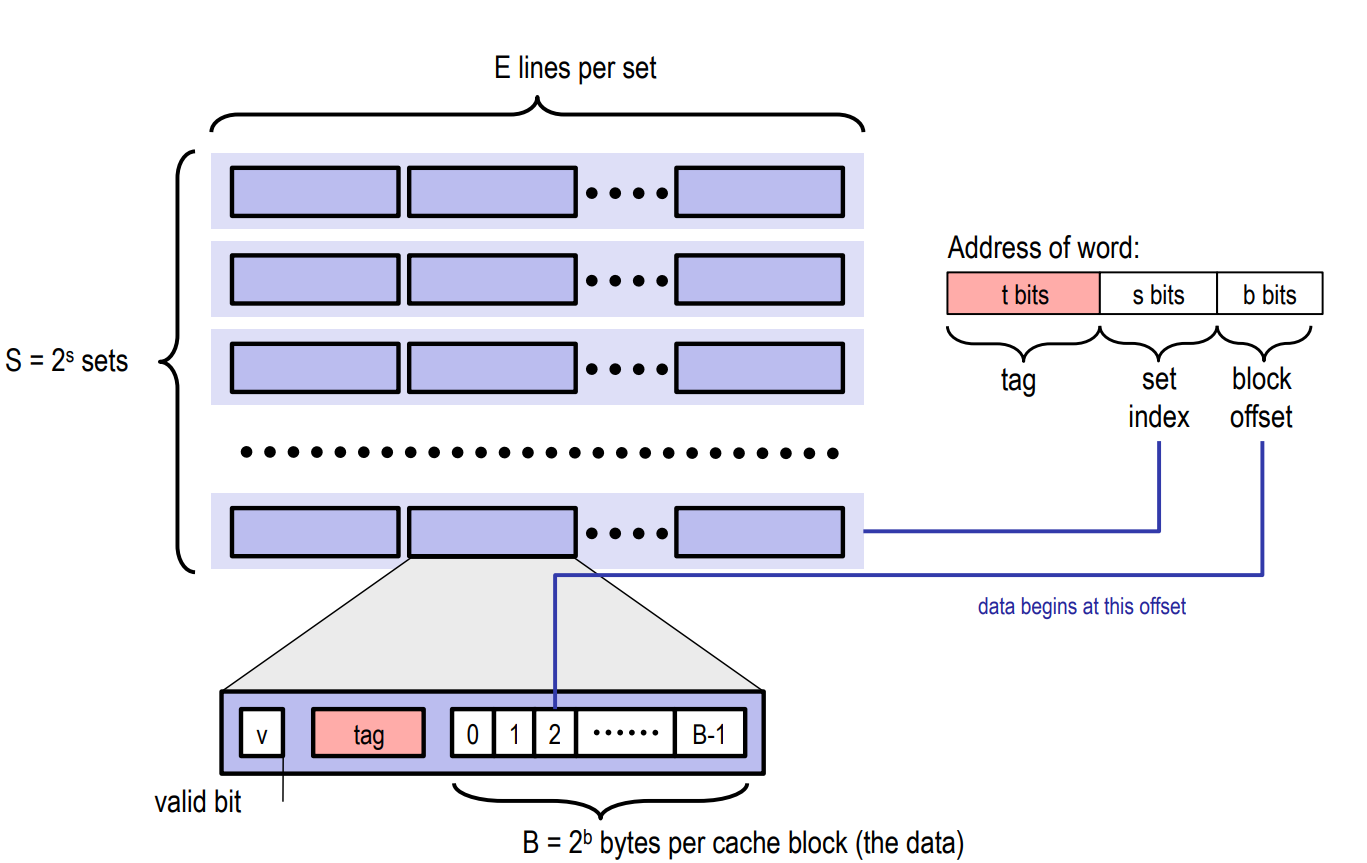
E = 1:直接映射
S = 1:全相联映射
处理写操作的方法 #
cache处理写操作的流程比读取要复杂,因为写入操作涉及数据的更改,一旦涉及修改操作,就会带来各种一致性问题,因此cache需要合理的处理数据更改的时机和范围。同时还需要处理写miss的情况。我们在这里简要介绍一下有关写cache的一些问题和处理机制。
一般而言,对于写入操作,cache一般有两种处理机制,分别是:
- write back(写回):即数据的修改只发生在当前这一级cache中,通常会引入一个dirty标记位,表示cache中的数据和下一级cache(或内存)中的数据不一致,只有在当前的cacheline被evict的时候才会将数据写回到下一级cache(或内存)。
- write through(写直达):顾名思义,写入操作会同时将数据写入到当前cache和下一级cache(或内存中),因此二者的数据是同步的。
除了上述的两种策略,cache还需要确定如何处理write miss的情况,一般而言,也有两种方法:
- write allocate(写分配):当发生cache miss时,需要访问下一级cache(或内存)将需要的cache line加载到当前cache中,然后再修改这个cache line中的内容
- no write allocate(写不分配):当发生cache miss时,无需修改当前cache中的内容,直接写入下一级cache(或内存)
上述策略两两组合可以产生4种不同的写策略,但是一般常见的只有以下两种:
-
write back/write allocate:即写回+写分配策略(图片来自wiki)
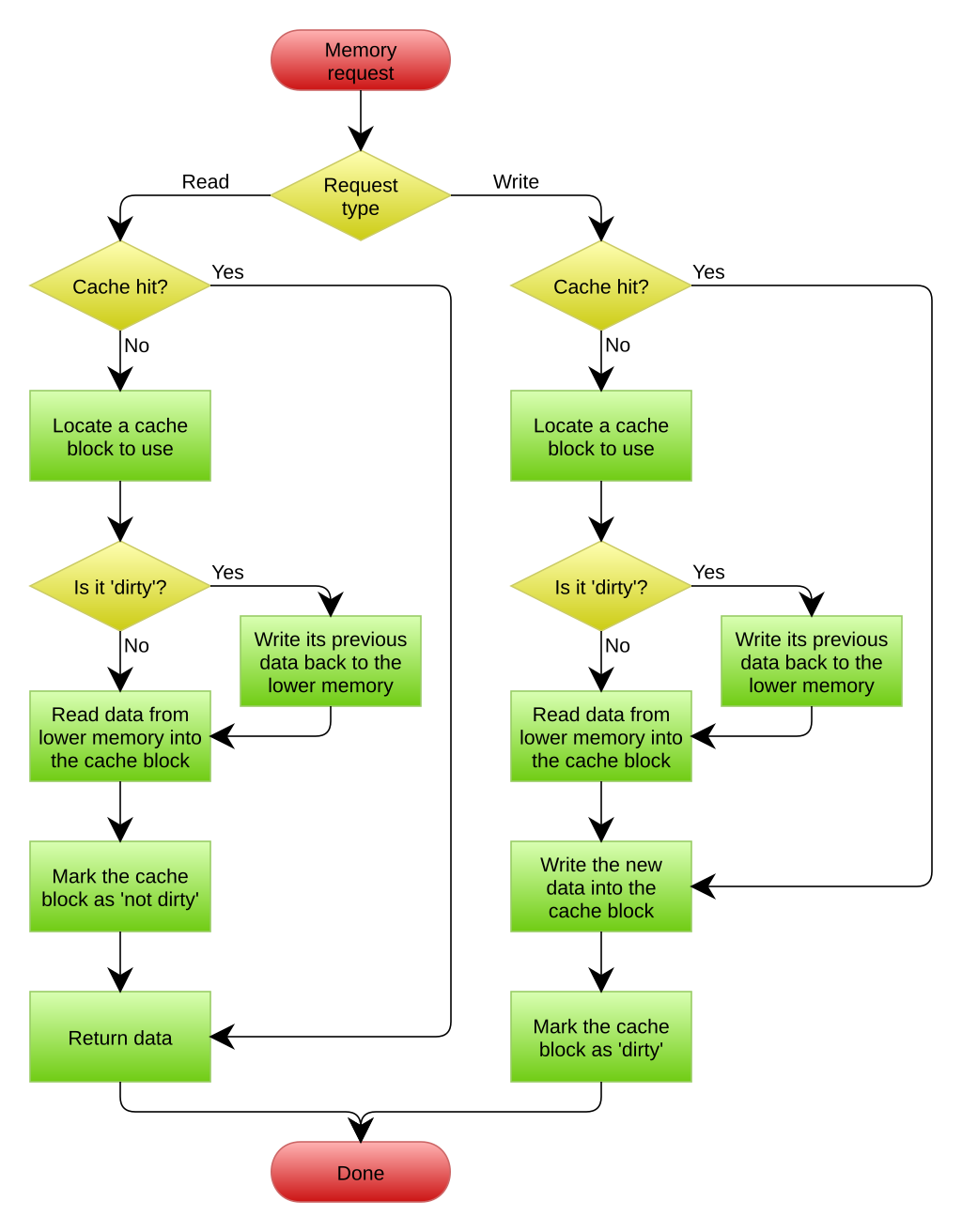
write through/no write allocate:即写直达+写不分配策略
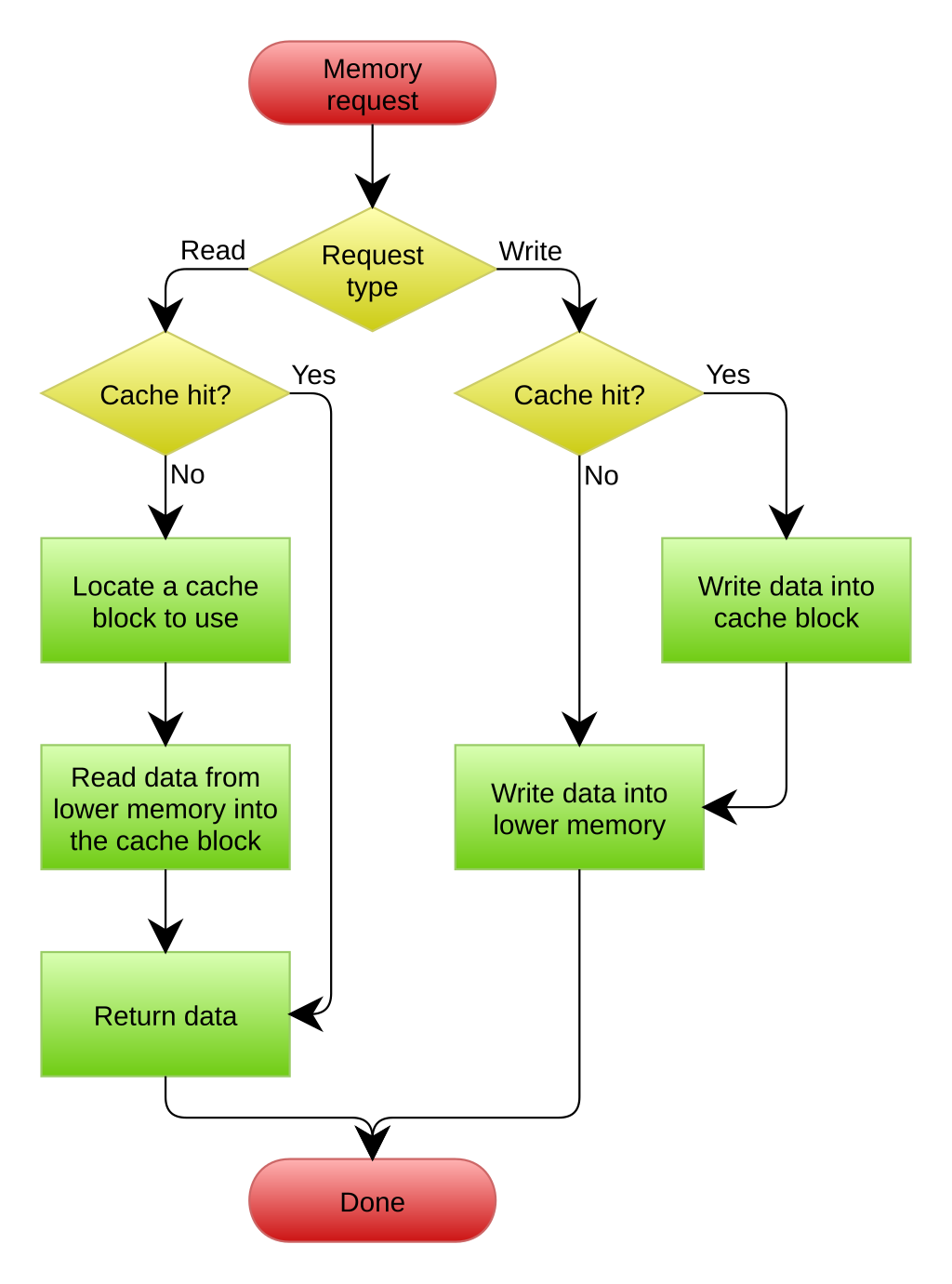
Q:为什么没有写回和写不分配的操作?
A:试想一下这样的情况:有二级缓存L1和L2,我们在L1写某个内存时发生了CacheMiss,假如我们写这个的概率很高,那么这块内存应该加载到L1才更加合理,但是每次都会发生CacheMiss,这不符合时间局部性的要求。另外一种方式也可以这样思考一下。
多级cache的包含准则(inclusion policy) #
这是本Lab的重中之重,请务必仔细理解。
包含性策略:更高层次的,访问速度更快的cache包含的内容是下层cache的一个子集。
现代处理器中的 L1 和 L2 Cache 可能采用不同的 一致性策略,主要有:
- 包容式(Inclusive)Cache:L2 必须包含 L1 中的所有数据。
- 非包容式(Non-Inclusive)Cache:L1 和 L2 不必强制包含相同数据,可以各自缓存不同的数据。
- 独占式(Exclusive)Cache:L1 和 L2 不共享数据,数据只存在一个层级。
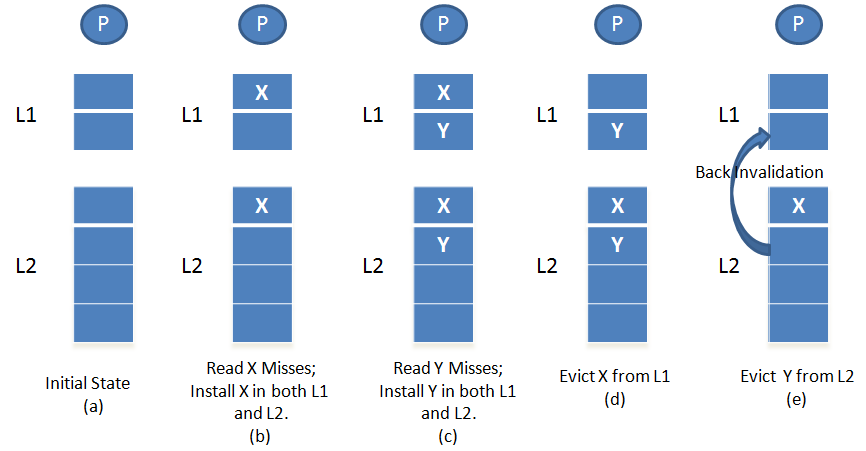
如上图的一个模拟情况:
多余不再赘述,我们只需要注意这样两点:
1.上层的存储不断Cache Miss时,直到找到没有Cache Miss的这样一层,接着要把这个数据加载到之前Cache Miss的每一层。
2.当下层的存储发生Cache Evict时,我们要把这一层之上的所有这个数据置为无效,显然,对于Inclusive Policy,如果不驱逐就不满足子集条件。
三级Cache模拟器 #
我们要实现这样一个Cache:

-
L1分为L1D(数据读写)和L1I(指令读取)两个分离的cache,并且L1I是只读的。
-
L1和L2为每个核心私有
-
L2为unfied cache,也就是会同时存储指令和数据
-
L3为unfied cache,且所有核心共享
每个Cache的具体配置,方便查阅:
每个cache的具体配置如下:
- L1D(I) cache
- size: 64B
- set: 4
- associativity: 2-way
- cache line size: 8B
- write policy: write back + write allocate
- L2 cache
- size: 256B
- set: 8
- associativity: 4-way
- cache line size: 8B
- write poliy: write back + write allocate
- inclusion policy: inclusive
- L3 cache
- size: 2KB
- set: 16
- associativity: 8-way
- cache line size: 16B
- write policy: write back + write allocate
- inclusion policy: inclusive
- L1D(I) cache
我们实现单核的CPU中的缓存机制,不考虑并发访问和与核心的缓存一致性问题。
小小吐槽一下:我们学校的助教简直已经把lab喂到嘴里了,把一整个lab变成了leetcode一样的核心代码模式,这样不好,但是门槛会变低。
(对不起,误会了,还是挺难的……)
先读一下定义的头文件:
/*
* cachelab.h - Prototypes for Cache Lab helper functions
*/
#ifndef CACHE_LAB_H
#define CACHE_LAB_H
#include <stdbool.h>
#include <stdint.h>
#define L1_SET_NUM 4
#define L1_LINE_NUM 2
#define L1_CACHELINE_SIZE 8
#define L2_SET_NUM 8
#define L2_LINE_NUM 4
#define L2_CACHELINE_SIZE 8
#define L3_SET_NUM 16
#define L3_LINE_NUM 8
#define L3_CACHELINE_SIZE 16
#define ADDRESS_LENGTH 64
#define MAX_TRANS_FUNCS 100
//核心的CacheLine是一个结构体
typedef struct {
bool valid;
bool dirty;
uint64_t tag;
uint64_t latest_used; // for LRU
} CacheLine;
typedef struct trans_func {
void (*func_ptr)(int M, int N, int[N][M], int[M][N]);
char *description;
char correct;
unsigned int num_hits;
unsigned int num_misses;
unsigned int num_evictions;
} trans_func_t;
// defined in csim.c
extern CacheLine l1dcache[L1_SET_NUM][L1_LINE_NUM];
// L1 Instruction Cache
extern CacheLine l1icache[L1_SET_NUM][L1_LINE_NUM];
// L2 Unified Cache
extern CacheLine l2ucache[L2_SET_NUM][L2_LINE_NUM];
// L2 Unified Cache
extern CacheLine l3ucache[L3_SET_NUM][L3_LINE_NUM];
/* Fill the matrix with data */
void initMatrix(int M, int N, int A[N][M], int B[M][N]);
/* The baseline trans function that produces correct results. */
void correctTrans(int M, int N, int A[N][M], int B[M][N]);
/* Add the given function to the function list */
void registerTransFunction(void (*trans)(int M, int N, int[N][M], int[M][N]),
char *desc);
#endif
实现的时候我们按照如下的顺序(程序框图,假设我们在访问第i级Cache):
- 根据内存地址得到相应的tag,set字段的值
- 检查第 i 级cache是否命中
- 如果命中,跳到第8步
- 否则,继续访问下一级cache(或内存)获取数据
- 在本级cache对应的set中找一个invalid的cache line,用于放置从下一级cache(或内存)加载的cache line,如果有多个invalid的cache line,选择下标最小的一个,然后跳到第8步
- 如果在第5步对应的set已满,你需要首先evict一个cache line,evict的过程使用LRU算法,如果evict的cache line是dirty的,你需要首先将其写入到下一级缓存(或内存)
- 由于inclusive policy,你可能需要back invalidation第 i - 1 级cache中的cache line
- 设置这个cache line对应的tag字段,LRU字段和valid字段
- 如果访问模式是写操作,设置dirty字段
- 返回
给了我们一个例子,我来看看……
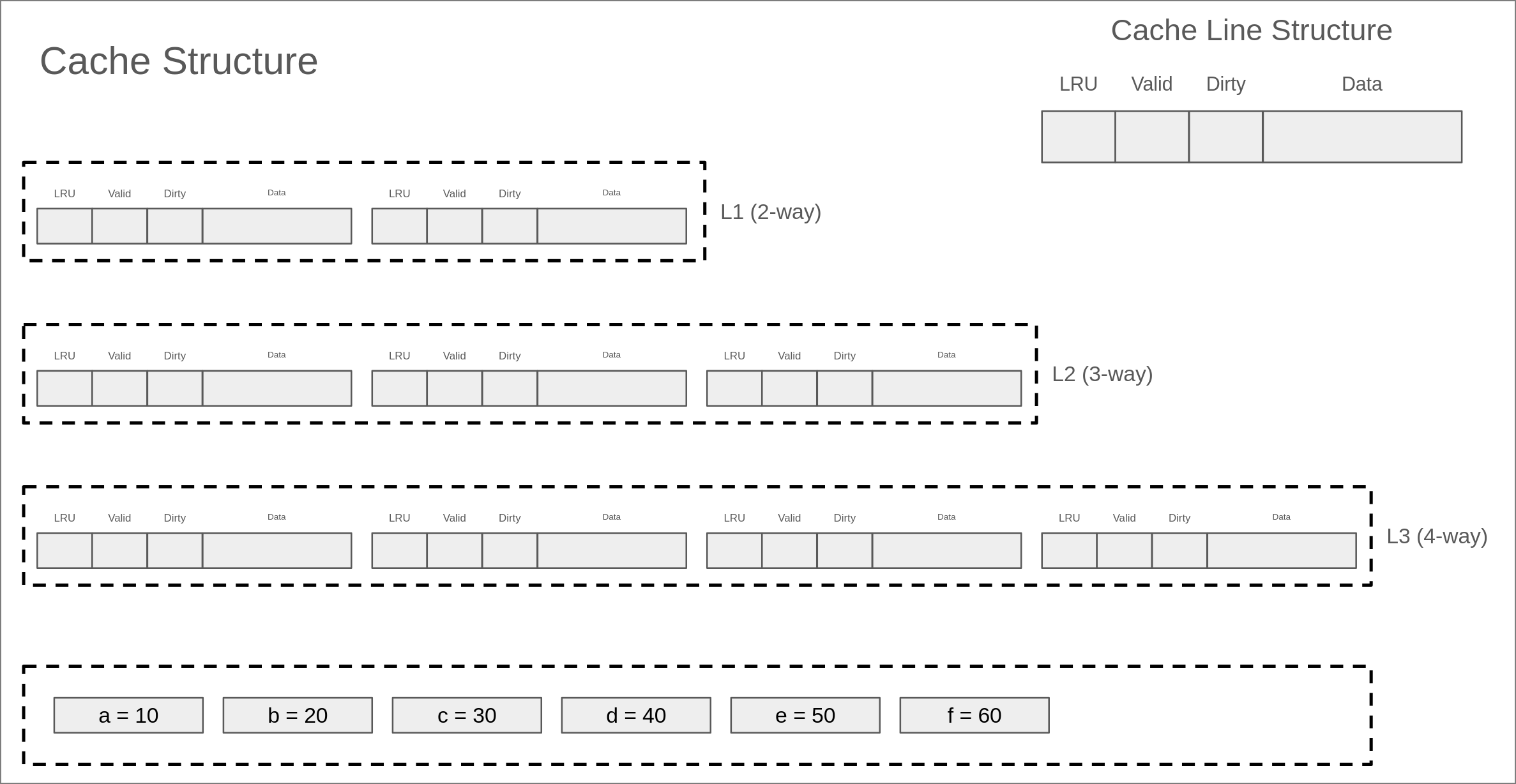
cache的访问trace依次为:
- Read a
- Read b
- Read a
- Write b
- Read c
- Write a
- Read d
- Read c
- Write b
- Write c
- Read e
- Read f
- Read b
- Read d
画一画吧,这个还是挺复杂的,最复杂的地方就在于驱逐的时候Back Invalidation的逻辑。
助教给出的一些注意事项:
在访问cache之前,你需要正确的初始化所有的cache line, 换句话说,你需要把所有的字段全部初始化为0
你可以假设,对于单个cache的访问,不会出现跨两个cache line的情况,换句话说,你可以忽略cacheAccess函数中的第三个参数
对于
M类型的访问,你可以等价的将他看作为一次读取和一次写入需要注意的是,L2和L3 cache会同时包含指令和数据
你可以假设指令和数据不会访问同一块内存,换句话说,你可以假设L2中的某个cache line不会同时出现在L1D cache和L1I cache中
这里TMD是这样的么,我假设访问一块内存之后就过了一堆样例(也有可能是我误人子弟了。。。。。。)
本次实验仅要求模拟cache访问,因此你无需关心具体的写入数据
你可以使用位运算相关技巧从传入的地址中提取出tag,set,block等信息
你可以使用位运算相关技巧根据tag,set,block的信息拼接出内存地址
在加载一条cache line时,你需要在当前cache set中找出一条可用的cache line, 换句话说,你需要找到一条valid字段为false的cache line。如果有多条可用的cache line,你需要选择下标最小的一个
你需要严格使用LRU算法来找到需要evict的cache line
你可以简单使用循环的方式来暴力实现LRU,而不考虑复杂度的问题,为此,你可以维护一个全局时钟并且仔细的设置cache line结构中的latest_used字段
在evict一条cache line时,你需要考虑dirty字段的影响,换句话说,如果dirty为true,你需要在加载新的cache line之前,将旧的cache line写回到下一级cache(或内存)。如果dirty为false,你可以简单的将这条cache line丢弃
你在进行evict的时候,无需对evict的cache line的LRU字段进行改动
你需要在每次成功访问一条cache line之后设置LRU字段,成功访问指写入/读取命中,或者是从下级缓存加载了相应的cache line之后的读取/写入操作
在发生conflict miss时,你需要严格遵守先fetch,后evict的过程,即先访问下一级缓存或者内存得到数据所在的cache line,再选择需要evict的cache line,这可能会影响LRU设置的顺序。考虑一个例子,假如某个时刻全局时钟为10,L1发生conflict miss,L2 hit,你需要首先访问L2,由于L2 hit,设置L2中对应的cache line的LRU为10,然后将cache line返回给L1,假设L1需要evict的cache line是dirty的,你需要将其首先写回L2,这是100% hit的(为什么?),因此设置L2中对应的cache line的LRU为11,最后将需要的cache line放置在L1经evict空出的位置上,然后设置对应的LRU为12
本次实验要求上一级cache的内容一定存在于下一级cache中,这叫做inclusive policy。你需要时刻保证这一条性质,并且好好利用它
受限于inclusive policy,写回脏数据的过程实际上是100% hit的,你需要合理的安排代码顺序实现这一点
当你处理write miss时,需要首先访问下一级缓存(或者内存)获取cache line,然后再写入这条cache line。在此过程中,你需要仔细思考对于下一级缓存应该以什么类型进行访问
如果你需要从L2 evict某个cache line,假设这个cache line也存在于L1, 你需要将L1中对应的cache line也进行evict,这个过程叫做back invalidation。如果L1中的数据是dirty的,你需要首先将其写回L2。
如果你需要从L3 evict一个cache line,你也需要分别将L1和L2中对应的cache line进行evict。在此过程中,你需要好好思考evict的顺序,以保证inclusive的性质。
注意,不同级别的缓存cache line的大小可能是不一样,你在设计代码的时候需要考虑这会产生哪些影响,并仔细的处理相关流程
vscode ctrl + shift + I整理代码
我草,debug快疯了……(debug日记)
//分析一下错误
Testcase Lines Result Random Score
---------------------------------------------------------------------------------
traces-data-intensive/long.trace 267988 FAIL IGNORE 0/3
Details for trace <traces-data-intensive/long.trace>
Your simulator Reference simulator
Level Hits Misses Evicts Hits Misses Evicts
L1 D 231249 55715 53833 230444 56520 53285
L1 I 0 0 0 0 0 0
L2 46998 26645 26424 47391 27797 24629
L3 32061 10181 10053 33435 11645 11517
hits 和 misses的和相等,但是差刚好差了805,hits多了,misses少了,随之evict也会变多,这应该不是计数而是逻辑的问题
races-basic/mixed-2.trace 90 FAIL IGNORE 0/5
Details for trace <traces-basic/mixed-2.trace>
Your simulator Reference simulator
Level Hits Misses Evicts Hits Misses Evicts
L1 D 20 60 52 20 60 52
L1 I 18 12 7 17 13 6
L2 71 43 15 71 44 16
L3 19 28 0 21 28 0
为什么I指令自己没错,分开都没错,但是结合到一起就出错了,两者之间为什么会相互影响???
traces-hard/grep.trace 406467 FAIL IGNORE 0/1
Details for trace <traces-hard/grep.trace>
Your simulator Reference simulator
Level Hits Misses Evicts Hits Misses Evicts
L1 D 37304 1068 949 22544 15828 502
L1 I 184075 184064 184034 184075 184064 184016
L2 176099 9087 9055 118023 81983 81951
L3 6693 2413 2285 79669 2416 2288
L3hits之间差距过大,L2中的数据没有及时驱逐???
先放这,休息一下再看。
已经拿了76分,但实在是很难找到剩下的逻辑错误!煎熬!
OK,最后拿了93分,差一点点实在是找不出来为啥了,不贴源代码了,写了六七百行能跑的垃圾,之后再精简总结一下,这下是真尽力了,我感觉已经不是一个设计的问题了,到最后我甚至要去猜哪里的设计提示是不是说的有问题,有错误,那就没有意思了对么……
最后应该是因为三层地址中block位并不一样的原因,这里要细节处理一下,因为你直接把L3的block干成0,可能会对于L2的setIndex位产生影响。
我放代码:
1.我写的代码很垃圾,放的没有意义(主要是时间很紧张,压缩一下应该能在300行左右)。
2.维护学术诚信。
关于Cache的一些思考 #
也不算很深,进一步探究一下,以下都是我自己或者问gpt得到的观点,自己的一些看法,如果您对于某个问题有着更好的理解,欢迎在评论区指出来,这里我说的低级cache或者下层的cache指的是靠近内存的cache。
1. #
在这个实验中一直强调的一个点是Inclusive policy,这种设计方法在以前的CPU,特别是Intel的CPU中很常见,但其实现代的CPU以及逐渐转向使用NINE模式,因此会产生以下问题:
-
使用Inclusive policy的缓存必须满足什么条件?这样设计的优缺点分别是什么?
底层缓存必须包含上层的缓存,在底层缓存驱逐的时候要做back invalidation。
好处:
好判断,多核的时候很好知道高级缓存的内容是否存在于低级缓存之中。
缺点:
冗余数据驱逐:L2 驱逐某数据时,即使 L1 正在频繁使用,也必须一并驱逐它,增加了不必要的 L1 miss。
容量浪费:为了维护包含关系,L2 的一些空间可能被迫用于保持与 L1 相同的数据,降低了有效利用率。
降低性能上限:高级缓存未能成为真正的“补充层”,而是受限于 L1 的命中内容。
-
NINE策略不要求低级cache强制包含高级cache内容,这样做相比inclusive的好处和坏处分别是什么?
(NINE:Non-Inclusive, Non-Exclusive)
NINE就是说下层的cache和上层的cache,二者之间不要求下层cache一定要包含上层cache的内容,同时也不要求两层cache之间的内容一定要是相互排斥的。
好处:
减少了数据冗余,提高了缓存的利用率,当下层的cache要被驱逐的时候,不会影响上层的cache,从而导致没有必要的cache miss。
缺点:
我很难保证一致性的问题,并且数据的管理相对复杂(NINE就是在包含性和排他性策略之间的一种状态),比如说我在L2 cache hit了之后,决定到底要不要把这个数据加载到L1中去之后干掉L2,包含性就是不能干掉,排他性就是必须干掉。
-
本次实验实际上借助inclusive的性质大大简化了设计,如果采用NINE结构,你将如何调整你的代码?
首先去除back invalidation的这部分逻辑,其次和上一个问题一样,我要设置premote下层cacheline的一个逻辑。
2. #
现代CPU几乎都采用L1D和L1I两种缓存结构,而在L2及更低级的缓存使用统一指令和数据的方式,这么做的好处是什么?
以下是gpt的回答(我觉得写的还好,是否合理我也就不算很清楚了):
✅ 为什么 L1 要分成 L1D 和 L1I?
➕ 好处一:提高访问带宽(并行性)
- CPU 在每个周期通常同时需要取指(fetch instruction)和访问数据。
- 如果 L1 是 unified 的,指令和数据会争用同一个缓存端口(cache port)。
- 分离 L1I 和 L1D 后,CPU 能 同时读取指令和访问数据,实现并发访问,提升执行效率。
➕ 好处二:降低访问延迟(latency)
- L1 是最靠近执行核心的缓存,需要尽可能小而快。
- 分开管理指令和数据,可以让 L1I 和 L1D 各自做更有针对性的优化,例如:
- L1I 可以预取、预测分支;
- L1D 可以更好地处理 load/store、写缓冲等。
➕ 好处三:避免污染和干扰
- 指令和数据的访问模式差异很大:
- 指令访问具有更强的顺序性、局部性好;
- 数据访问则可能跳跃、随机、重复读取。
- 分开缓存避免了数据污染指令缓存(或反之),提升命中率和稳定性。
✅ 为什么 L2/L3 使用 unified cache?
➕ 原因一:提高缓存利用率
- L2/L3 体积更大(通常是几百 KB 到几十 MB)。
- 如果分为 I-cache 和 D-cache,则可能出现:
- L2D 已满但 L2I 还有空闲空间(或反之);
- 导致资源浪费。
- Unified cache 可以动态地根据访问需求分配空间,更灵活。
➕ 原因二:简化设计,节省成本
- L2/L3 远离核心,访问延迟更高,并发访问不再是瓶颈。
- 统一设计结构更简单,不需要分别维护 tag、替换策略等逻辑。
➕ 原因三:有助于 cache coherence 协议的实现
- 多核共享的 L3 cache 使用统一结构更方便跟踪、标记和通信,便于维护一致性。
3. #
你觉得CPU是如何区分指令内存和数据内存的访问的?
1.现代 CPU 内部有清晰划分的模块:
- 取指单元(Instruction Fetch Unit) 专门负责取指令
- 加载/存储单元(Load/Store Unit) 专门负责读写数据
这两者访问内存的路径不同,进而访问不同的 Cache 层次结构(如 L1I vs. L1D)。
2.从软件视角来看:
- 编译器把「执行代码」转成了存放在某段内存中的机器指令
- 把「变量数据」分配到另一块内存空间
于是,在 CPU 运行时:
- 指令指针(
PC/IP)发出的访问是“取指” - 普通 Load/Store 指令发出的访问是“访问数据”
也就是说根据发出指令的操作单元就可以说明这个指令究竟是I还是L指令。
4. #
本次实验要求实现严格的LRU算法,一种暴力实现方式是遍历所有cache line, 这样时间复杂度为O(E),你可以设计一种复杂度为O(1)的实现方式吗?
一道关于LRUCahce的lc,你应该能很好的理解为什么?https://leetcode.cn/problems/lru-cache/description/
这是实现的Java代码(我之前写过很多Java代码)
//Least Recently Used
//最近最少使用
//HashMap + DoublyLinkedList
class LRUCache {
//简单的双向链表
class Node{
int key;
int val;
Node prev;
Node next;
public Node(){}
public Node(int _key, int _val){key = _key; val = _val;}
}
private Map<Integer, Node> cache;
private int size;
private int capacity;
private Node head;
private Node tail;
//初始化缓存
public LRUCache(int capacity) {
cache = new HashMap<>();
this.size = 0;
this.capacity = capacity;
head = new Node();
tail = new Node();
head.next = tail;
tail.prev = head;
}
//相当于读取内存,读取成功这个值就返回value,并且放到双向链表的头部,否则返回-1(实际上要从内存中获取)
public int get(int key) {
if(cache.containsKey(key)){
moveToHead(cache.get(key));
return cache.get(key).val;
}
return -1;
}
//写值,道理类似
public void put(int key, int value) {
if(cache.containsKey(key)){
Node node = cache.get(key);
node.val = value;
moveToHead(node);
}else{
++size;
if(size > capacity){
--size;
Node d = tail.prev;
remove(d);
cache.remove(d.key);
}
Node node = new Node(key, value);
cache.put(key, node);
add(node);
}
}
//一旦get或者put,就放到head之后,作为最新的节点
private void moveToHead(Node node){
remove(node);
add(node);
}
//一旦过容量,或者其他场景,删除节点
private void remove(Node node){
Node p = node.prev;
Node n = node.next;
p.next = n;
n.prev = p;
}
//新put进来的元素,加到头节点之后
private void add(Node node){
Node n = head.next;
head.next = node;
node.prev = head;
node.next = n;
n.prev = node;
}
}
基本就是利用;双向链表和hashmap,这样当我们给出一个值,我可以根据这个值直接找到对应的cacheline和在linkedlist中对应的node,直接把这个node提前到head位置,那么这个节点就是最新的,tail之前的节点就是最老的。
虽然是O(1),但是实际的开销并不会小。
5. #
LRU算法在某种特定的情形下会造成100% miss,你可以发现这种访问模式吗?
LRU Thrashing(LRU抖动)
比如这样,你的L1cache现在只有一个set,三行line,我对于四个元素A B C D进行循环的访问,那么开始就会
依次加入 A B C
接着读取D miss 去除A 放置D
接着读取A miss 去除B 放置A
接着读取B miss 去除 C 放置B
……
上面这样的情况就会100%miss。
6. #
实际硬件中,实现LRU算法其实十分昂贵,因此大多数厂家采用近似LRU的方法,如果让你设计,你会如何设计这种算法?
来自于gpt,讲的并不好理解,可以看看https://en.wikipedia.org/wiki/Pseudo-LRU
Pseudo-LRU (PLRU)
实现:
- 最常见的是 二叉树 PLRU(Binary Tree Pseudo LRU):
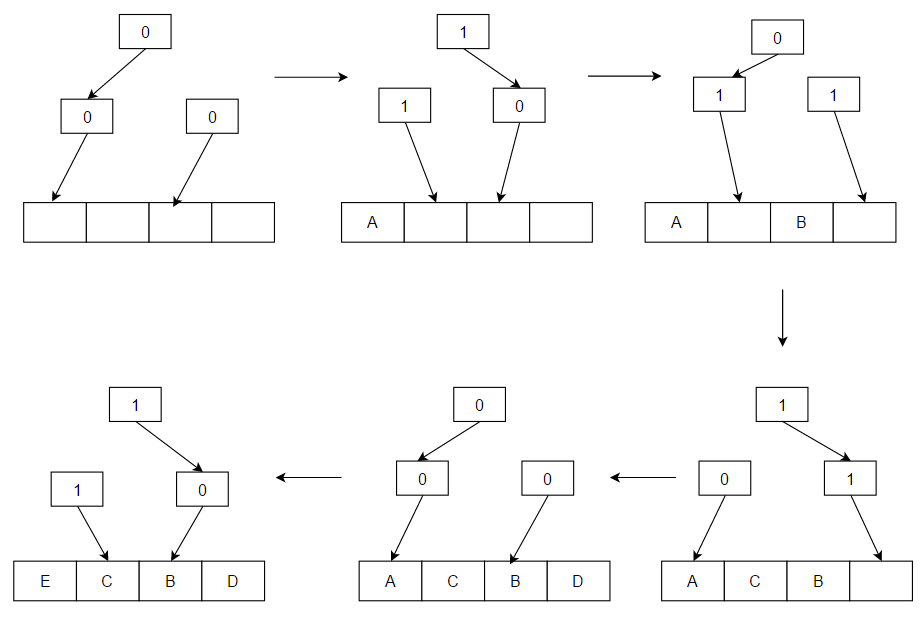
- 适用于 4、8、16 路组相联 Cache。
- 维护一个“树状指针结构”,每个节点记录最近访问的是左还是右。
- 总共只需 E - 1 个 bit 就能表示选择哪条 line 替换。
原理图:
(b1)
/ \
(b2) (b3)
/ \ / \
A B C D
- 每个内部节点 0/1 表示最近访问的是哪一侧
- 选择替换线时,从根节点走向“最久未访问的方向”
举个例子:
b0,b1,b2是 3 个位(bit),分别控制走向哪个子树。- 每个 bit 记录“最近使用的是哪一边”。
这些 bit 可以这样理解:
- 如果
b0 = 0,表示最近访问的是左子树(A、B),因此优先替换右子树(C、D) - 如果
b1 = 1,表示在左子树中,最近访问的是 B → 替换 A - 如果
b2 = 0,表示在右子树中,最近访问的是 C → 替换 D
从根开始,按照 bit 的指示往“没被最近访问过”的方向走,直到到达一个叶子节点(就是要被替换的 cache line)。
然后反过来,更新路径上的 bit,表示刚刚走过的那条路径是“最近访问过的”。
假设当前:
b0 = 0→ 上次用了左边(A 或 B)b1 = 1→ 上次用了 Bb2 = 0→ 上次用了 C
替换时:
- 从 b0 看 0 → 最近访问的是左边 → 应该替换右边
- 进入 b2,看 0 → 最近访问的是 C → 应该替换 D
✅ 所以选择替换 D
然后把:
b0 = 1(因为现在访问右边)b2 = 1(访问了 D)
优点:
- 硬件实现简单,开销低
- 实际效果在很多场景下接近 LRU
缺点:
- 并不是真正的最久未使用,有可能替换到常用块
7. #
本次实验中在实现上有个小细节是,在发生conflict miss时,我们总是先从下一级fetch数据,然后再判断是否需要evict,这样做的好处和不足是什么?如果上述两个操作的流程互换之后,带来的好处和坏处是什么?你可能需要综合考虑inclusive policy带来的影响。
如果仅有一层cache和memory,那么先后顺序是无所谓的。
我们用两层Cache和memory来理解一下这个问题:
L1 L2 memory
现在我访问L1 miss,L1满了,直接把那个要放入位置的数据驱逐掉。
又访问L2 miss,L2满了,驱逐,此时要考虑back invalidation,如果L1包含,那么那行cacheline也要驱逐掉,但是此时back invalidation的cacheline,和L1时候就驱逐的cacheline有可能是一行cacheline,这是否造成了浪费。
现在再从memory取值放入L2,L1刚刚驱逐的位置。
| 方案 | 优点 | 缺点 |
|---|---|---|
| 先 fetch 后 evict(实验采用) | - 避免 Inclusive 引起的无意义 invalidate - 更稳定一致性 - 实现简单 | - 延迟高 - 有时多余 fetch |
|---|---|---|
| 先 evict 后 fetch | - 可优化延迟 - 有可能并行处理 | - 易与 Inclusive 冲突 - 需要额外状态管理 |
|---|---|---|
8. #
进行cache访问时,需要根据内存地址提取出tag,set等字段,而CPU产生的地址实际上都是虚拟地址,需要额外的机制转换成物理地址(详见虚拟内存章节)。因此,cache的设计实际上可以分成physical index和virtual index两种方式,即采用物理地址或者虚拟地址两种地址解析tag,set等内容,那么:
-
使用physical index的cache的优缺点是什么?
避免了别名的问题,要TLB转换,带来延迟。
-
使用virtual index的cache的优缺点是什么?
访问会变快,但是有别名的问题。
-
你能不能设计一种方法综合利用上述两种方式各自的优势?
不能(?)
折中方案:VIPT(Virtual Index, Physical Tag) #
先用虚拟地址索引(提取 index),用物理地址比对(tag)
优势: #
- 保留了虚拟访问的速度优势(用虚拟 index 找 set)
- 同时 用物理 tag 避免 alias 问题
- 是 现代 L1 Cache 的主流设计(只要满足 index bits 不跨 page boundary)
设计要点: #
- Page offset 不变,必须保证 index bits 落在 page offset 范围(否则访问前无法知道 index)。
- 比如:
- 页大小:4KB = 12 bits offset
- Index bits ≤ 12
- Tag 用物理地址中除去 index + block offset 部分
学过一点Java多线程,但是还没有系统学过OS,多少能理解一下多线程的问题,到这里已经相当复杂了,我就不再纸上谈兵了。
9. #
本次实验中实现的模拟器只能应对顺序访问,如果需要扩展你的模拟器以支持多个线程并发访问,你该如何调整现有的代码?
每一组cacheset用mutex(互斥🔓),保证任何一个时刻,一个set最多仅有一个thread访问。
原子操作LRU等数据。
如果您有更好的看法,欢迎在评论区直接指出!
10. #
本次实验中不要求考虑多核之间的一致性问题,如果考虑多核之间一致性的问题,且L3作为多核之间的共享缓存,你该如何调整现有的代码?
11. #
在考虑多核之间cache一致性的前提下,如果需要将inclusive策略变成NINE策略,你需要如何改进现有的代码?
成品代码:
在我的github上也有,在你自己实现的时候会发现很多相似的逻辑,想想怎么封装,本来应该是一个很精妙的代码构成。
#include "cachelab.h"
#include <stdint.h>
#include <stdio.h>
#include <stdlib.h>
// 可能要包含的头文件
// 要不要封装功能?具体实现的方式
// 先写的时候可以不急着做功能抽象,先写出来试试看
// Q:当我在l2中访问缓存命中时,我要把这个地址加载回l1,但是由于这个地址已经确定,那么不会出现明明有空但是必须驱逐的现象么
// 相关数据统计量,是我在实现的过程中要进行维护的 容易忘记 一共3 * 4 = 12个数据
// 当一个地址给定的时候,它的所有的SetIndex就已经定下来了
// 注意C语言的{}的风格
int l1d_hits = 0;
int l1d_misses = 0;
int l1d_evictions = 0;
int l1i_hits = 0;
int l1i_misses = 0;
int l1i_evictions = 0;
int l2_hits = 0;
int l2_misses = 0;
int l2_evictions = 0;
int l3_hits = 0;
int l3_misses = 0;
int l3_evictions = 0;
// 定义一些常量
#define L1S 2
#define L1B 3
#define L2S 3
#define L2B 3
#define L3S 4
#define L3B 4
#define INSTRUCTION 0
#define DATA 1
//@params time:要使用LRU算法维护的一个全局时钟
int timeStamp = 0;
// 全局变量加载默认初始化为0
void cacheInit()
{
}
// 拼接地址,假设填充的偏移字节不会产生影响:都用0来做填充
// 这里要好好检查有没有出错
uint64_t addressConcate(uint64_t tag, uint64_t setIndex, int s, int b)
{
uint64_t addr = ((tag << (s + b)) | (setIndex << b));
return addr;
}
// 把驱逐一个CacheLine的功能封装一下,要考虑无效回溯的情况,但是我很难封装到一个function里面去,最好写成四个function
// 要驱逐的cacheLine地址
// 并且合理利用包含准则
// 直接把地址作为参数,复用性是不是会更强--->我的目的还是为了少传送几个参数
// 这几个驱逐的函数只是单纯的做驱逐的处理,但是不会加载新的值
// lru找要不要也封装?这样对地址操作有可能出错吗?
// 还要对于统计量进行操作
// 要考察是不是无效回溯导致的驱逐,如果是,那么这里不应该算进去统计的问题
// l1i是一个只读的内存,
void evictCacheLineFroml1i(uint64_t evictAddress, bool isBackInvalidation)
{
uint64_t tag = (evictAddress >> (L1S + L1B));
uint64_t setIndex = ((evictAddress >> L1B) & 0b11);
int evictIndex = -1;
for (int index = 0; index < L1_LINE_NUM; ++index)
{
// 找到了要驱逐的行
if (l1icache[setIndex][index].valid && l1icache[setIndex][index].tag == tag)
{
evictIndex = index;
break;
}
}
// 没有要驱逐的行,因为要考虑Back Invalidation
if (evictIndex == -1)
{
return;
}
// 有要驱逐的行
if (!isBackInvalidation)
{
++l1i_evictions;
}
l1icache[setIndex][evictIndex].valid = false;
}
// L1dcache的驱逐的逻辑和L1icahce的逻辑应该是类似的,其实不是
void evictCacheLineFroml1d(uint64_t evictAddress, bool isBackInvalidation)
{
uint64_t tag = (evictAddress >> (L1S + L1B));
uint64_t setIndex = ((evictAddress >> L1B) & 0b11);
int evictIndex = -1;
for (int index = 0; index < L1_LINE_NUM; ++index)
{
// 找到了要驱逐的行
if (l1dcache[setIndex][index].valid && l1dcache[setIndex][index].tag == tag)
{
evictIndex = index;
break;
}
}
// 没有要驱逐的行,因为要考虑Back Invalidation
if (evictIndex == -1)
return;
if (!isBackInvalidation)
{
++l1d_evictions;
}
// 有要驱逐的行
l1dcache[setIndex][evictIndex].valid = false;
if (l1dcache[setIndex][evictIndex].dirty)
{
uint64_t tag2 = (evictAddress >> (L2S + L2B));
uint64_t setIndex2 = ((evictAddress >> L2B) & 0b111);
for (int index = 0; index < L2_LINE_NUM; ++index)
{
if (l2ucache[setIndex2][index].valid && l2ucache[setIndex2][index].tag == tag2)
{
// L2的这个Cache被写了,更改timeStamp
++l2_hits;
++timeStamp;
l2ucache[setIndex2][index].latest_used = timeStamp;
l2ucache[setIndex2][index].dirty = true;
return;
}
}
}
}
// 从l2ucache驱逐,还要考虑你驱逐的是i还是d
void evictCacheLineFroml2(uint64_t evictAddress, int TYPE, bool isBackInvalidation)
{
if (!isBackInvalidation)
{
uint64_t tag = (evictAddress >> (L2S + L2B));
uint64_t setIndex = ((evictAddress >> L2B) & 0b111);
int evictIndex = -1;
for (int index = 0; index < L2_LINE_NUM; ++index)
{
if (l2ucache[setIndex][index].valid && l2ucache[setIndex][index].tag == tag)
{
evictIndex = index;
}
}
// 没有找到要驱逐的位置
if (evictIndex == -1)
{
return;
}
// 这里要进行驱逐
// 首先从l2ucache驱逐要考虑无效回溯
// L2 back Invalidation L1的时候不应该给L1算一次evict?
++l2_evictions;
evictCacheLineFroml1d(evictAddress, true);
evictCacheLineFroml1i(evictAddress, true);
l2ucache[setIndex][evictIndex].valid = false;
// 直接驱逐的情况
if (l2ucache[setIndex][evictIndex].dirty)
{
uint64_t tag3 = (evictAddress >> (L3S + L3B));
uint64_t setIndex3 = ((evictAddress >> L3B) & 0b1111);
for (int index = 0; index < L3_LINE_NUM; ++index)
{
if (l3ucache[setIndex3][index].valid && l3ucache[setIndex3][index].tag == tag3)
{
++l3_hits;
++timeStamp;
l3ucache[setIndex3][index].latest_used = timeStamp;
l3ucache[setIndex3][index].dirty = true;
return;
}
}
}
}
else
{
uint64_t tag = (evictAddress >> (L2S + L2B));
uint64_t setIndex = ((evictAddress >> L2B) & 0b111);
int evictIndex = -1;
for (int index = 0; index < L2_LINE_NUM; ++index)
{
if (l2ucache[setIndex][index].valid && l2ucache[setIndex][index].tag == tag)
{
evictIndex = index;
evictCacheLineFroml1d(evictAddress, true);
evictCacheLineFroml1i(evictAddress, true);
l2ucache[setIndex][evictIndex].valid = false;
// 直接驱逐的情况
if (l2ucache[setIndex][evictIndex].dirty)
{
uint64_t tag3 = (evictAddress >> (L3S + L3B));
uint64_t setIndex3 = ((evictAddress >> L3B) & 0b1111);
for (int i = 0; i < L3_LINE_NUM; ++i)
{
if (l3ucache[setIndex3][i].valid && l3ucache[setIndex3][i].tag == tag3)
{
++l3_hits;
++timeStamp;
l3ucache[setIndex3][i].latest_used = timeStamp;
l3ucache[setIndex3][i].dirty = true;
}
}
}
}
}
if (setIndex % 2 == 0)
{
++setIndex;
evictIndex = -1;
for (int index = 0; index < L2_LINE_NUM; ++index)
{
if (l2ucache[setIndex][index].valid && l2ucache[setIndex][index].tag == tag)
{
evictIndex = index;
evictCacheLineFroml1d(evictAddress, true);
evictCacheLineFroml1i(evictAddress, true);
l2ucache[setIndex][evictIndex].valid = false;
// 直接驱逐的情况
if (l2ucache[setIndex][evictIndex].dirty)
{
uint64_t tag3 = (evictAddress >> (L3S + L3B));
uint64_t setIndex3 = ((evictAddress >> L3B) & 0b1111);
for (int i = 0; i < L3_LINE_NUM; ++i)
{
if (l3ucache[setIndex3][i].valid && l3ucache[setIndex3][i].tag == tag3)
{
++l3_hits;
++timeStamp;
l3ucache[setIndex3][i].latest_used = timeStamp;
l3ucache[setIndex3][i].dirty = true;
}
}
}
}
}
}
if (setIndex % 2 == 1)
{
--setIndex;
evictIndex = -1;
for (int index = 0; index < L2_LINE_NUM; ++index)
{
if (l2ucache[setIndex][index].valid && l2ucache[setIndex][index].tag == tag)
{
evictIndex = index;
evictCacheLineFroml1d(evictAddress, true);
evictCacheLineFroml1i(evictAddress, true);
l2ucache[setIndex][evictIndex].valid = false;
// 直接驱逐的情况
if (l2ucache[setIndex][evictIndex].dirty)
{
uint64_t tag3 = (evictAddress >> (L3S + L3B));
uint64_t setIndex3 = ((evictAddress >> L3B) & 0b1111);
for (int i = 0; i < L3_LINE_NUM; ++i)
{
if (l3ucache[setIndex3][i].valid && l3ucache[setIndex3][i].tag == tag3)
{
++l3_hits;
++timeStamp;
l3ucache[setIndex3][i].latest_used = timeStamp;
l3ucache[setIndex3][i].dirty = true;
}
}
}
}
}
}
}
}
// 从l3ucache驱逐,同样要考虑驱逐的类型问题
void evictCacheLineFroml3(uint64_t evictAddress, int TYPE)
{
uint64_t tag = (evictAddress >> (L3S + L3B));
uint64_t setIndex = ((evictAddress >> L3B) & 0b1111);
int evictIndex = -1;
for (int index = 0; index < L3_LINE_NUM; ++index)
{
if (l3ucache[setIndex][index].valid && l3ucache[setIndex][index].tag == tag)
{
evictIndex = index;
break;
}
}
if (evictIndex == -1)
{
return;
}
// Back Invalidation
++l3_evictions;
evictCacheLineFroml2(evictAddress, INSTRUCTION, true);
l3ucache[setIndex][evictIndex].valid = false;
}
// TODO:思考fetch函数组的封装有没有问题
// 想把一个line从L2fetch到l1i
void fetchl2tol1i(uint64_t setIndex1, uint64_t tag1)
{
// 维护l1驱逐的情况
int evictIndexl1i = -1;
uint64_t minTimeStampl1i = UINT64_MAX;
for (int j = 0; j < L1_LINE_NUM; ++j)
{
// 能找到L1也存在无效的情况,最好的情况
if (!l1icache[setIndex1][j].valid)
{
++timeStamp;
l1icache[setIndex1][j].latest_used = timeStamp;
l1icache[setIndex1][j].dirty = false;
l1icache[setIndex1][j].tag = tag1;
l1icache[setIndex1][j].valid = true;
return;
}
// 要给l1驱逐的情况
else
{
if (l1icache[setIndex1][j].latest_used < minTimeStampl1i)
{
minTimeStampl1i = l1icache[setIndex1][j].latest_used;
evictIndexl1i = j;
}
}
}
// 先给l1i做驱逐
uint64_t evictL1iAddress = addressConcate(l1icache[setIndex1][evictIndexl1i].tag, setIndex1, L1S, L1B);
evictCacheLineFroml1i(evictL1iAddress, false);
// 此时l1i已经驱逐完毕,驱逐完了之后再fetch进去
++timeStamp;
l1icache[setIndex1][evictIndexl1i].latest_used = timeStamp;
l1icache[setIndex1][evictIndexl1i].dirty = false;
l1icache[setIndex1][evictIndexl1i].tag = tag1;
l1icache[setIndex1][evictIndexl1i].valid = true;
}
// 把一个line从L2fetch到l1d
void fetchl2tol1d(uint64_t setIndex1, uint64_t tag1)
{
int evictIndexl1d = -1;
uint64_t minTimeStampl1d = UINT64_MAX;
for (int j = 0; j < L1_LINE_NUM; ++j)
{
if (!l1dcache[setIndex1][j].valid)
{
++timeStamp;
l1dcache[setIndex1][j].latest_used = timeStamp;
l1dcache[setIndex1][j].dirty = false;
l1dcache[setIndex1][j].tag = tag1;
l1dcache[setIndex1][j].valid = true;
return;
}
else
{
if (l1dcache[setIndex1][j].latest_used < minTimeStampl1d)
{
minTimeStampl1d = l1dcache[setIndex1][j].latest_used;
evictIndexl1d = j;
}
}
}
uint64_t evictL1dAddress = addressConcate(l1dcache[setIndex1][evictIndexl1d].tag, setIndex1, L1S, L1B);
evictCacheLineFroml1d(evictL1dAddress, false);
++timeStamp;
l1dcache[setIndex1][evictIndexl1d].latest_used = timeStamp;
l1dcache[setIndex1][evictIndexl1d].dirty = false;
l1dcache[setIndex1][evictIndexl1d].tag = tag1;
l1dcache[setIndex1][evictIndexl1d].valid = true;
}
// 把一个line从L3fetch到L2
void fetchl3tol2(uint64_t setIndex2, uint64_t tag2, int TYPE)
{
uint64_t minTimeStamp = UINT64_MAX;
// 如果满了,要驱逐的index
int evictIndex = -1;
for (int i = 0; i < L2_LINE_NUM; ++i)
{
if (!l2ucache[setIndex2][i].valid)
{
++timeStamp;
l2ucache[setIndex2][i].latest_used = timeStamp;
l2ucache[setIndex2][i].dirty = false;
l2ucache[setIndex2][i].tag = tag2;
l2ucache[setIndex2][i].valid = true;
return;
}
else
{
if (l2ucache[setIndex2][i].latest_used < minTimeStamp)
{
minTimeStamp = l2ucache[setIndex2][i].latest_used;
evictIndex = i;
}
}
}
// 考虑L2的驱逐
uint64_t evictaddressl2 = addressConcate(l2ucache[setIndex2][evictIndex].tag, setIndex2, L2S, L2B);
evictCacheLineFroml2(evictaddressl2, TYPE, false);
++timeStamp;
l2ucache[setIndex2][evictIndex].latest_used = timeStamp;
l2ucache[setIndex2][evictIndex].dirty = false;
l2ucache[setIndex2][evictIndex].tag = tag2;
l2ucache[setIndex2][evictIndex].valid = true;
}
// 把一个内存中的值fetch到l3
void fetchMemoryTol3(uint64_t setIndex3, uint64_t tag3, int TYPE)
{
int evictIndex = -1;
uint64_t minTimeStamp = UINT64_MAX;
for (int index = 0; index < L3_LINE_NUM; ++index)
{
if (!l3ucache[setIndex3][index].valid)
{
++timeStamp;
l3ucache[setIndex3][index].latest_used = timeStamp;
l3ucache[setIndex3][index].dirty = false;
l3ucache[setIndex3][index].tag = tag3;
l3ucache[setIndex3][index].valid = true;
return;
}
else
{
if (l3ucache[setIndex3][index].latest_used < minTimeStamp)
{
minTimeStamp = l3ucache[setIndex3][index].latest_used;
evictIndex = index;
}
}
}
uint64_t evictAddress = addressConcate(l3ucache[setIndex3][evictIndex].tag, setIndex3, L3S, L3B);
evictCacheLineFroml3(evictAddress, TYPE);
++timeStamp;
l3ucache[setIndex3][evictIndex].latest_used = timeStamp;
l3ucache[setIndex3][evictIndex].dirty = false;
l3ucache[setIndex3][evictIndex].tag = tag3;
l3ucache[setIndex3][evictIndex].valid = true;
}
/* 我们先写一个Instruction尝试一下:读取指令
* @params addr 为访问地址,它是trace文件中的地址的十进制表示的结果,64位16进制内存地址
* OK:经过纯I指令检测,这个函数实现的没有问题
*/
void instruct(uint64_t addr)
{
// 先访问第一级Cache,处理addr
uint64_t tag1 = (addr >> (L1S + L1B));
uint64_t setIndex1 = ((addr >> L1B) & 0b11);
uint64_t tag2 = (addr >> (L2S + L2B));
uint64_t setIndex2 = ((addr >> L2B) & 0b111);
uint64_t tag3 = (addr >> (L3S + L3B));
uint64_t setIndex3 = ((addr >> L3B) & 0b1111);
// 根据拿到的数据看第一级有没有命中
for (int index = 0; index < L1_LINE_NUM; ++index)
{
// 合法并且tag相同,就是命中
if (l1icache[setIndex1][index].valid && l1icache[setIndex1][index].tag == tag1)
{
// 命中之后的处理
++timeStamp;
++l1i_hits;
l1icache[setIndex1][index].latest_used = timeStamp;
return;
}
}
// 到这里证明l1i没有命中,在l2中找
++l1i_misses;
for (int index = 0; index < L2_LINE_NUM; ++index)
{
// l2中缓存命中
if (l2ucache[setIndex2][index].valid && l2ucache[setIndex2][index].tag == tag2)
{
++timeStamp;
l2ucache[setIndex2][index].latest_used = timeStamp;
++l2_hits;
fetchl2tol1i(setIndex1, tag1);
return;
}
}
// 到这里证明l2没有命中,在l3中找
++l2_misses;
for (int index = 0; index < L3_LINE_NUM; ++index)
{
// l3缓存命中
if (l3ucache[setIndex3][index].valid && l3ucache[setIndex3][index].tag == tag3)
{
++timeStamp;
l3ucache[setIndex3][index].latest_used = timeStamp;
++l3_hits;
fetchl3tol2(setIndex2, tag2, INSTRUCTION);
fetchl2tol1i(setIndex1, tag1);
return;
}
}
// 到这里证明l3没有命中,要从缓存中取值加载到三层里面去
++l3_misses;
// 找要驱逐的L3的地址
fetchMemoryTol3(setIndex3, tag3, INSTRUCTION);
fetchl3tol2(setIndex2, tag2, INSTRUCTION);
fetchl2tol1i(setIndex1, tag1);
// 理论上到这里取值令的过程已经结束
}
// 读取数据的问题,读取数据和读取指令是否是类似的
void load(uint64_t addr)
{
// 先访问第一级Cache,处理addr
uint64_t tag1 = (addr >> (L1S + L1B));
uint64_t setIndex1 = ((addr >> L1B) & 0b11);
uint64_t tag2 = (addr >> (L2S + L2B));
uint64_t setIndex2 = ((addr >> L2B) & 0b111);
uint64_t tag3 = (addr >> (L3S + L3B));
uint64_t setIndex3 = ((addr >> L3B) & 0b1111);
// 根据拿到的数据看第一级有没有命中
for (int index = 0; index < L1_LINE_NUM; ++index)
{
// 合法并且tag相同,就是命中
if (l1dcache[setIndex1][index].valid && l1dcache[setIndex1][index].tag == tag1)
{
// 命中之后的处理
++timeStamp;
++l1d_hits;
l1dcache[setIndex1][index].latest_used = timeStamp;
return;
}
}
++l1d_misses;
for (int index = 0; index < L2_LINE_NUM; ++index)
{
// l2中缓存命中
if (l2ucache[setIndex2][index].valid && l2ucache[setIndex2][index].tag == tag2)
{
++timeStamp;
l2ucache[setIndex2][index].latest_used = timeStamp;
++l2_hits;
fetchl2tol1d(setIndex1, tag1);
return;
}
}
// 到这里证明l2没有命中,在l3中找
++l2_misses;
for (int index = 0; index < L3_LINE_NUM; ++index)
{
// l3缓存命中
if (l3ucache[setIndex3][index].valid && l3ucache[setIndex3][index].tag == tag3)
{
++timeStamp;
l3ucache[setIndex3][index].latest_used = timeStamp;
++l3_hits;
fetchl3tol2(setIndex2, tag2, DATA);
fetchl2tol1d(setIndex1, tag1);
return;
}
}
// 到这里证明l3没有命中,要从缓存中取值加载到三层里面去
++l3_misses;
// 找要驱逐的L3的地址
fetchMemoryTol3(setIndex3, tag3, DATA);
fetchl3tol2(setIndex2, tag2, DATA);
fetchl2tol1d(setIndex1, tag1);
}
// 重点逻辑:写入内存的实现
// 先fetch这个cacheline,接着才进行改动,我这里成了先改动,再fecth上去,肯定是不行的
// 简单来说,写入操作是不会影响L2和L3的
void store(uint64_t addr)
{
// 先列出所有可能要访问的数据
uint64_t tag1 = (addr >> (L1S + L1B));
uint64_t setIndex1 = ((addr >> L1B) & 0b11);
uint64_t tag2 = (addr >> (L2S + L2B));
uint64_t setIndex2 = ((addr >> L2B) & 0b111);
uint64_t tag3 = (addr >> (L3S + L3B));
uint64_t setIndex3 = ((addr >> L3B) & 0b1111);
// 写l1d
for (int index = 0; index < L1_LINE_NUM; ++index)
{
// l1d write hit
if (l1dcache[setIndex1][index].valid && l1dcache[setIndex1][index].tag == tag1)
{
++l1d_hits;
++timeStamp;
l1dcache[setIndex1][index].latest_used = timeStamp;
l1dcache[setIndex1][index].dirty = true;
return;
}
}
// l1d write misses
++l1d_misses;
// 在L2中写
for (int index = 0; index < L2_LINE_NUM; ++index)
{
// l2 write hit
if (l2ucache[setIndex2][index].valid && l2ucache[setIndex2][index].tag == tag2)
{
// L2写命中,我先把这个位置加载回l1d,接着才进行dirty的修改,写命中时,首先更改一下lru
++l2_hits;
++timeStamp;
l2ucache[setIndex2][index].latest_used = timeStamp;
fetchl2tol1d(setIndex1, tag1);
for (int i = 0; i < L1_LINE_NUM; ++i)
{
// 在fetch了之后,此时这里的lru已经发生了改变,所以是不是不用再进行更改?
// 应该是的
if (l1dcache[setIndex1][i].valid && l1dcache[setIndex1][i].tag == tag1)
{
l1dcache[setIndex1][i].dirty = true;
return;
}
}
}
}
// l2u write misses
++l2_misses;
for (int index = 0; index < L3_LINE_NUM; ++index)
{
// l3 write hit
if (l3ucache[setIndex3][index].valid && l3ucache[setIndex3][index].tag == tag3)
{
++l3_hits;
++timeStamp;
l3ucache[setIndex3][index].latest_used = timeStamp;
fetchl3tol2(setIndex2, tag2, DATA);
fetchl2tol1d(setIndex1, tag1);
for (int i = 0; i < L1_LINE_NUM; ++i)
{
if (l1dcache[setIndex1][i].valid && l1dcache[setIndex1][i].tag == tag1)
{
l1dcache[setIndex1][i].dirty = true;
return;
}
}
}
}
// l3u write miss,在内存中写,然后直接加载上去,是否正确,显然错误
++l3_misses;
fetchMemoryTol3(setIndex3, tag3, DATA);
fetchl3tol2(setIndex2, tag2, DATA);
fetchl2tol1d(setIndex1, tag1);
// 在fetch完了之后,在set1中找要写的值,接着写入即可
for (int i = 0; i < L1_LINE_NUM; ++i)
{
if (l1dcache[setIndex1][i].valid && l1dcache[setIndex1][i].tag == tag1)
{
l1dcache[setIndex1][i].dirty = true;
return;
}
}
}
// you are not allowed to modify the declaration of this function
/*cacheAccess函数接受三个参数,参数的定义为:
* 而且我们不考虑byte的个数,我们这个函数只是模拟访问内存的操作,不实际读写数据
*@params op 为访问类型,是一个char类型的参数,具体取值和trace文件中的类型相同,为[I, S, L,M]其中的一个。
*@params addr 为访问地址,它是trace文件中的地址的十进制表示的结果,64位16进制内存地址
*@params len 为一次访问的长度,也就是字节数量
* 思考过程:
* 1.怎么处理地址?要根据不同缓存级别的组数用不同的方式来解读地址么?然后剩下的位都是tag标志
* 2.I是指令加载的过程,和数据读取类似,但是一级缓存中只能从L1I中来读取指令数据
* 3.M修改数据,就是一次Load加上一次Store Load:就是读取 Store:就是写入数据
* 4.代码框架大概是怎样的?一个对应的指令实现一个功能?
*/
void cacheAccess(char op, uint64_t addr, uint32_t len)
{
switch (op)
{
case 'I':
instruct(addr);
break;
case 'M':
load(addr);
store(addr);
break;
case 'L':
load(addr);
break;
case 'S':
store(addr);
break;
default:
break;
}
}

